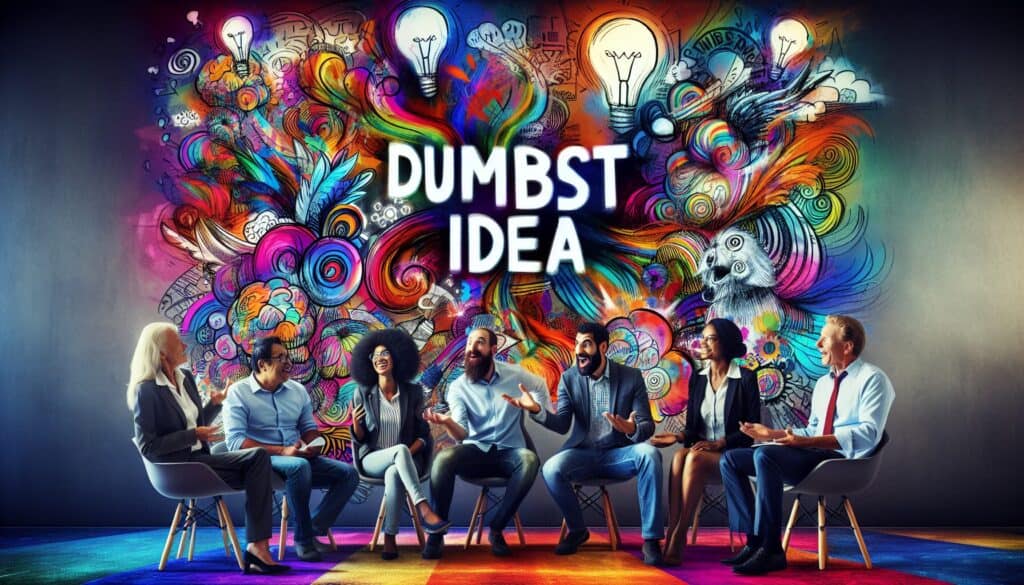这是一种头脑风暴技术,参与者有意产生不切实际、愚蠢或 "笨 "的想法,以此放松自己,打破创意障碍,激发更多创新思维。
- 方法: 客户与营销, 精益西格玛, 产品设计
最愚蠢的想法优先(最糟糕的想法)

最愚蠢的想法优先(最糟糕的想法)
- 敏捷方法论, 集思广益, 持续改进, 创造力, 跨职能协作, 设计思维, 构思, 创新, 解决问题的技巧
目标
如何使用
- 小组的工作重点是提出最糟糕或最不可行的问题解决方案。然后,这些糟糕的想法就会被推翻,或成为好想法的垫脚石。
优点
- 减少对评判的恐惧,鼓励参与;可以为会议注入幽默和活力;通过挑战假设,不好的想法往往可以激发出真正好的、非传统的想法。
缺点
- 如果推动不力,可能会被某些人视为浪费时间;需要转变观念,看到 "坏 "想法的价值;需要一个后续过程来转变或发扬这些想法。
类别
- 构思
最适合:
- 克服创意障碍,从故意提出的坏点子入手,营造更加开放的构思环境。
This methodology is particularly applicable in industries such as software development, consumer electronics, and product innovation, where creative solutions are fundamental to success. During brainstorming sessions, teams can shift the focus from conventional thinking to deliberately absurd concepts, facilitating a more relaxed atmosphere that diminishes the fear of criticism. Participants typically include cross-functional team members, such as designers, engineers, marketing experts, and end-users, who bring diverse perspectives that can enhance the depth of ideation. This approach can be particularly useful in the early phases of project development, where clarifying goals and challenges is crucial. For instance, a team tasked with developing a new app might initially list out the most impractical features or functionalities, using these “worst ideas” to dissect what wouldn’t work and why, thereby illuminating viable options and promoting creative breakthroughs. This technique is often employed alongside other ideation processes, such as design thinking or agile methodologies, enriching the creative pipeline by challenging existing assumptions and pushing the boundaries of what is considered feasible. Organizations like IDEO have utilized similar tactics to invigorate their design processes, and tech companies often harness this method during innovation workshops to catalyze product evolution. These sessions can inject humor and energy, transforming problem-solving into an engaging and collaborative endeavor, reinforcing team dynamics while generating unexpected insights that can form the basis for robust design solutions.
该方法的关键步骤
- Define the problem or challenge clearly.
- Encourage participants to generate the worst possible ideas without filtering.
- Document all bad ideas without judgment.
- Analyze the bad ideas for underlying assumptions and thought patterns.
- Identify elements from the bad ideas that can be reversed or improved.
- Develop new ideas by transforming the worst ideas into potential solutions.
- Evaluate the new ideas for feasibility and potential effectiveness.
专业提示
- Encourage teams to adopt absurd 人们 or roles; this can shift their thinking and reveal unexpected angles.
- Incorporate timed bursts of idea generation for worst ideas; time pressure can lead to more bizarre and unfiltered suggestions.
- Facilitate a “reverse pitch” where team members argue why a bad idea could work; this forces deeper analysis and can reveal hidden merits.
历史背景
1949
1950
1950
1960
1960
1960
1960
1940
1950
1950
1958
1960
1960
1960
1960
(如果日期不详或不相关,例如 "流体力学",则对其显著出现的时间作了四舍五入的估计)。















相关文章
主生产计划(MPS)
大规模定制
营销漏斗
营销审计
MAPO 指数(医院病人的移动和援助)
制造资源计划(MRP II)